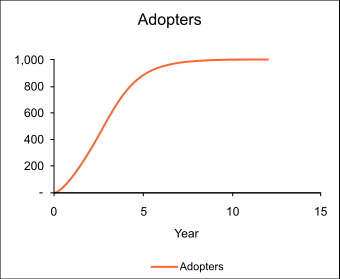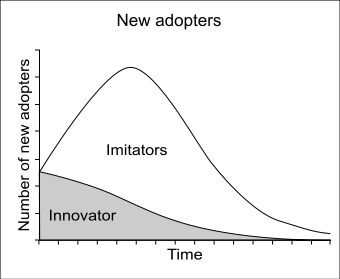Bass diffusion model
The Bass Model or Bass Diffusion Model was developed by Frank Bass. It consists of a simple differential equation that describes the process of how new products get adopted in a population. The model presents a rationale of how current adopters and potential adopters of a new product interact. The basic premise of the model is that adopters can be classified as innovators or as imitators and the speed and timing of adoption depends on their degree of innovativeness and the degree of imitation among adopters. The Bass model has been widely used in forecasting, especially new products' sales forecasting and technology forecasting. Mathematically, the basic Bass diffusion is a Riccati equation with constant coefficients.
In 1969, Frank Bass published his paper on a new product growth model for consumer durables.[1]:1833[2] Prior to this, Everett Rogers published Diffusion of Innovations, a highly influential work that described the different stages of product adoption. Bass contributed some mathematical ideas to the concept.[3]
Model formulation
Where:
- is the installed base fraction
- is the change of the installed base fraction, i.e.
- is the coefficient of innovation
- is the coefficient of imitation
Sales (or new adopters) at time is the rate of change of installed base, i.e., multiplied by the ultimate market potential . Under the condition , we have that
We have the decomposition where is the number of innovators at time , and is the number of imitators at time .
The time of peak sales
Explanation
The coefficient p is called the coefficient of innovation, external influence or advertising effect. The coefficient q is called the coefficient of imitation, internal influence or word-of-mouth effect.
Typical values of p and q when time t is measured in years:[4]
- The average value of p has been found to be 0.03, and is often less than 0.01
- The average value of q has been found to be 0.38, with a typical range between 0.3 and 0.5


Derivation
The Bass diffusion model is derived by assuming that the hazard rate for the uptake of a product or service may be defined as:
where is the probability density function and is the survival function, with being the cumulative distribution function. From these basic definitions in survival analysis, we know that:
Therefore, the differential equation for the survival function is equivalent to:
Integration and rearrangement of terms gives us that:
For any survival function, we must have that and this implies that . With this condition, the survival function is:
Finally, using the fact that , we find that the Bass diffusion model for product uptake is:
Extensions to the model
Generalised Bass model (with pricing)
Bass found that his model fit the data for almost all product introductions, despite a wide range of managerial decision variables, e.g. pricing and advertising. This means that decision variables can shift the Bass curve in time, but that the shape of the curve is always similar.
Although many extensions of the model have been proposed, only one of these reduces to the Bass model under ordinary circumstances.[5]

This model was developed in 1994 by Frank Bass, Trichy Krishnan and Dipak Jain:
where is a function of percentage change in price and other variables
Successive generations
Technology products succeed one another in generations. Norton and Bass extended the model in 1987 for sales of products with continuous repeat purchasing. The formulation for three generations is as follows:[6]
where
- is the incremental number of ultimate adopters of the ith generation product
- is the average (continuous) repeat buying rate among adopters of the ith generation product
- is the time since the introduction of the ith generation product
It has been found that the p and q terms are generally the same between successive generations.
Relationship with other s-curves
There are two special cases of the Bass diffusion model.
- The first special case occurs when q=0, when the model reduces to the Exponential distribution.
- The second special case reduces to the logistic distribution, when p=0.
The Bass model is a special case of the Gamma/shifted Gompertz distribution (G/SG): Bemmaor[7] (1994)
Use in online social networks The rapid, recent (as of early 2007) growth in online social networks (and other virtual communities) has led to an increased use of the Bass diffusion model. The Bass diffusion model is used to estimate the size and growth rate of these social networks. The work by Christian Bauchkage and co-authors[8] shows that the Bass model provides a more pessimistic picture of the future than alternative model(s) such as the Weibull distribution and the shifted Gompertz distribution.
Adoption of this Model
The model is one of the most cited empirical generalizations in marketing; as of October 2018 the paper "A New Product Growth for Model Consumer Durables" published in Management Science had (approximately) 8499 citations in Google Scholar[9].
This model has been widely influential in marketing and management science. In 2004 it was selected as one of the ten most frequently cited papers in the 50-year history of Management Science.[3] It was ranked number five, and the only marketing paper in the list. It was subsequently reprinted in the December 2004 issue of Management Science.[3]
See also
- Diffusion of innovation
- Forecasting
- Shifted Gompertz distribution
- Lazy User Model
References
- Bass, Frank M. (2004). "Comments on "A New Product Growth for Model Consumer Durables": The Bass Model". Management Science. 50 (12): 1833–1840. CiteSeerX 10.1.1.460.1976. doi:10.1287/mnsc.1040.0300.
Perhaps the first thing to notice about the paper that has come to be known as the "Bass Model" (Bass 1969) is the title. It contains a typo. The paper was published with the title: "A New Product Growth for Model Consumer Durables." The correct title should be: "A New Product Growth Model for Consumer Durables."
- Bass, Frank (1969). "A new product growth for model consumer durables". Management Science. 15 (5): 215–227. doi:10.1287/mnsc.15.5.215.
- Management Science 50 Number 12 Supplement, Dec 2004 ISSN 0025-1909 p1833-1840
- Mahajan, Vijay; Muller, Eitan; Bass, Frank (1995). "Diffusion of new products: Empirical generalizations and managerial uses". Marketing Science. 14 (3): G79–G88. doi:10.1287/mksc.14.3.G79.
- Bass, Frank M.; Trichy V. Krishnan; Dipak C. Jain (1994). "Why the Bass Model Fits without Decision Variables". Marketing Science. 13 (2): 203–223. doi:10.1287/mksc.13.3.203.
- Norton, John A.; Frank M. Bass (1987). "A Diffusion Theory Model of Adoption and Substitution for Successive Generations of High-Technology Products". Management Science. 33 (9): 1069–1086. CiteSeerX 10.1.1.565.4068. doi:10.1287/mnsc.33.9.1069.
- Bemmaor, Albert C. (1994). "Modeling the Diffusion of New Durable Goods: Word-of-Mouth Effect Versus Consumer Heterogeneity". In G. Laurent, G.L. Lilien & B. Pras (ed.). Research Traditions in Marketing. Boston: Kluwer Academic Publishers. pp. 201–223. ISBN 978-0-7923-9388-7.
- Bauckhage, Christian; Kersting, Kristian (2014). "Strong Regularities in Growth and Decline of Popularity of Social Media Services". arXiv:1406.6529 [cs.SI].
- https://scholar.google.com/scholar?hl=en&as_sdt=0%2C45&q=A+New+Product+Growth+for+Model+Consumer+Durables&btnG=